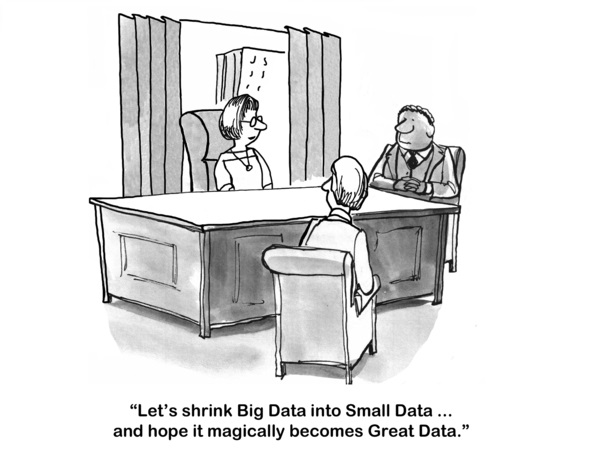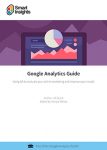Leading digital analytics experts share how to effectively use data and analytics
The number of data sources that are available is growing every day. For some of us this might be a good thing, but for many digital marketers it brings up a lot of challenges to deal with.
This report, Broken Links: Why analytics investments have yet to pay off, from the Economist Intelligence Unit (EIU) and global sales and marketing firm ZS, shows that there is still a long way to go. 70% of business executives say sales and marketing analytics is already very or even ìextremely important. This in contrast to 2% that say they have achieved broad, positive impact.
The question is, how can you most effectively use data and analytics to your business’ advantage?
Reporting vs. analysis
The job of a digital marketer and analyst is not to come up with a lot of fancy looking reports that contain tons of data. In my opinion, data is just input. The insights you provide should be your most important output.
When you have mastered numbers, you will in fact no longer be reading numbers, any more than you read words when reading books. You will be reading meanings.
~ W.E.B. Du Bois
You need to answer what the numbers mean to your business and what action should be taken to improve the most important metrics of the business.
Turn data into actionable insights
I have worked with many companies that really got stuck here. Being able to collect the right data is one thing, but making it extremely useful requires a different skill- and mindset.
Being able to collect the right data is one thing, but making it extremely useful requires a different skill- and mindset.
Based on surveying 49 Analytics experts I have compiled a list of the top 10 strategies to turn data into actionable insights.
1. Measure the right things
You can’t optimize what you don’t measure. There is not a one-size-fits-all solution. Every business is different and should be treated in a unique way.
Let’s assume you run an ecommerce site. In this case you probably want to know:
- Which channels drive the most conversions?
- What are your leaking buckets (places where people leave your website)?
- Whether people use multiple devices before purchasing your products?
- What are the look-to-buy ratios for your individual products and product categories?
- What landing pages need to be improved and in which channel?
You need to think in advance about what is important for your business. It all starts with a clear and concise measurement plan for your business and a good set of KPIs.
2. Ask the right questions to stakeholders
Go the extra mile to answer all of your stakeholderís questions. This means tapping into the stakeholderís aspirations and challenges by asking the right questions.
It’s a must to formulate a clear business question before you start your next data analysis. You can easily waste hours of your time by getting lost in your data. And coming up with “insights” that are already known or not deemed important can be highly frustrating as well!
3. Use segmentation to drive action
Go for segmentation if you want to take action on your data! By grouping visitors that have some attributes in common, you can start digging deeper. Choosing which segments to study depends on the business question you are trying to answer.
Identifying segments will greatly enhance your understanding of how your customers behave. You can use this information for setting up an optimization plan.

Digital analytics tools like Google Analytics come with a lot of built-in segments and provide you with all the freedom to customize them to your needs.
4. Use clear visualizations to convey your message
The way in which you present your data will make a huge difference in the outcome. Do you remember these presentations that only include numbers and words? And this compared to clear visualizations that promote cognition instead of confusion.
It’s important to articulate your specific data story with as much what, how and why behind it. This will turn your data into insights and profitable business decisions.
5. Discover the context of your data set
Everyone has got data and their own personal data driven insight (opinion). In most cases superior understanding of context leads to the best decisions.
Make sure to establish context for the data you are seeing. What do these numbers mean? Are they important? Does it really affect the business? And how is the data collected?
Data without context isn’t that meaningful and can actually lead to bad business decisions because of interpreting it in the wrong way!
6. Build a solid optimization plan
Use the “Define Measure Analyze Improve Control” process (DMAIC) to improve your business. It’s one of the Six Sigma concepts you can directly apply in your situation. In short it comes down to:
In short it comes down to:
- Define the problem or hypothesis, stakeholders and scope of analysis.
- Measure relevant data and conduct basic analysis to spot anomalies.
- Analyze correlations and patterns, put your statistics and visualization skills to work.
- Improvement based on insights and showing several options to explore.
- Control the change by deploying (A/B) tests and monitoring KPIs.
7. Construct a great hypothesis
A clearly articulated hypothesis is the start of any “analysis”. And the hypothesis should have the potential to drive action. Come up with your hypothesis by completing two fill-in-the-blank statements: 1) I believe __________. (this is the hypothesis), and 2) If I am right, we will __________. (this is the qualification).
Formulating these statements isn’t always easy, but you will save a ton of time wandering through your data and coming up with interesting – but not actionable – findings.
This article about the Lean Analytics Cycle is a great additional read.
8. Integrate data sources
The integration of data sources leads to better and faster business decisions. Think about integrating traditional databases with big data solutions (like Hadoop). Mining through and connecting all your sources will enhance your customer understanding and can deliver great insights.
9. Break down organizational silos
A healthy organization is the foundation of everything. Communication instead of confrontation. Inspire, motivate and be curious about the data and the possibilities it has for your organization. Treat any obstacles first and improve the communication between the business and analytics leaders.
10. Don’t forget to hire smart people
Tools can collect data, but people – who understand the business – build insights. Smart people are required to find the useful data, translate it into data-driven stories of useful knowledge – the insights. It’s a team effort where combining internal business experts with external analysts might be your best bet.
Pick your favorite strategy
Each of the strategies described above can help you fine-tune your action plan for turning data into insights and profits for your business. You might want to pick a few strategies and first experiment with them. Find out what works best in your industry and situation and go from there.
If you want further insights into the strategies that experts use, see the full results of the study.

